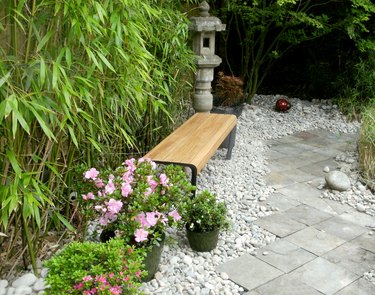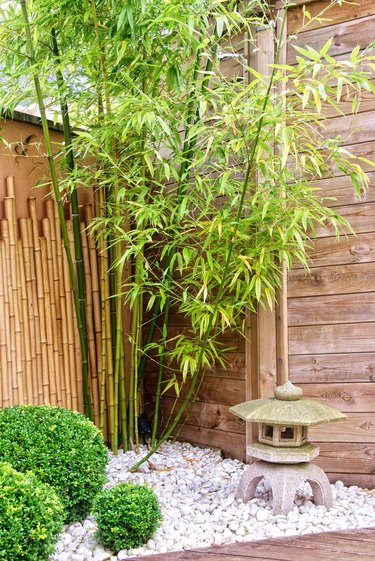
You may not think of your outdoor bamboo plants as part of your lawn, but maybe you should. Bamboo plants are large grasses that grow very tall very fast, making them great for screens, hedges and barriers. Bamboo also gives an exotic touch to a garden or backyard. Hundreds of different bamboo species are out there, but they generally fall into two categories, running and clumping. Both types require adequate irrigation, fertilizer and occasional pruning, but with running bamboo, you also have to check its invasive spread. Some localities prohibit bamboo planting, so check with your local gardening extension for your area's rules before you plant.
About Bamboo
Video of the Day
Bamboo are attractive and desirable garden plants and will serve you well, as long as you take care of them. Keep in mind that there are hundreds of types of bamboo with different genera. If you take the time to investigate, you can find one for almost every growing situation. If you need bamboo for a shady corner, try Chimonobambusa. If you want to plant bamboo in an area with direct sun, consider Phyllostachys. For an ordinary garden site, both Pseudosasa and Indocalamus are easy-grow and easy-care plants.
Video of the Day
Pick a type of bamboo that works with your hardiness zone as well. Generally, running bamboo is hardier than clumping, suited to USDA plant hardiness zones 8 and 9. Clumping bamboo thrives in zones 9 and 10. Also consider how tall you want your bamboo grass to grow. Some species top out at a yard high, but many grow to 10 or 20 feet.
Planting Tips
Spring is the best time to plant bamboo. If you are planting a hedge or screen, it's easiest to dig a trench about 2 feet deep rather than individual holes. Trench planting is definitely the way to go if you are planting running bamboo, because that makes it easier to add material to contain its aggressive spread. Use some material that bamboo roots cannot penetrate, and line the sides of the trench with it, allowing it to protrude a bit at the top. You can use paving slabs, corrugated iron sheets, precast concrete drain sections or root barrier fabric.
The bamboo plant rootballs should sit slightly lower than their previous depth. Add a layer of mulch over the roots or rhizomes to lock in moisture. Anything organic is fine, but nitrogen-rich grass cuttings work particularly well.
Irrigating Bamboo
Once you firm the earth around the newly planted bamboo roots, irrigate the area well. The newly planted bamboos will require frequent watering until the root/rhizome systems develop. Plan on irrigating twice a week in mild weather and more frequently during hot or windy weather. The primary reason new bamboo plants die is insufficient water during hot or windy weather.
Once a bamboo plant is mature, it requires less irrigation. Until it tops out in height, though, it requires lots of water and fertilizer to grow fast and well.
Fertilizing Bamboo
You'll need two different types of fertilizer for your bamboo, one to use in spring and the other for the remainder of the growing season. Bamboo plants need extra nitrogen in spring, so scatter a high-nitrogen granular fertilizer on the soil according to label directions, watering it in well. The rest of the growing season, a balanced fertilizer that is bamboo-specific or designed for grasses will work fine.
Pruning Bamboo
You don't have to prune your bamboo plants, but it can make them healthier and more attractive. Pruning involves cutting and removing the plants' culms, branches or leaves. Thinning bamboo means removing a stem altogether to give its neighbors more room. You'll need pruners or a saw, depending on what you are cutting. The best time to tackle this is late summer or fall.
Make pruning cuts just above a culm node or a branch node. The nodes will produce new leaves and eliminate that barren look. Note that once you remove part of the bamboo plant, that particular part will not regrow. For example, if you top a plant to maintain a desired height, that plant won't regrow to its former height. However, new shoots will emerge and may grow as tall or taller.
If you want to put the beautiful stem colors on display, you can prune out lower foliage in late summer after shoot production is over. Snap it off close to the stem with gloved hands, or cut it off as close to the stem as possible. Prune to control height or to thin the stand in late summer or fall. Make pruning cuts just above a joint in the stem.

Pests and Diseases
Gardeners get off easy when it comes to treating bamboo pests and diseases. Bamboos have few problems and are practically pest- and disease-free. However, indoor bamboo plants may attract pests like aphids, mealybugs and scales. Try washing these off with tap water.
Indoor Bamboo
Smaller types of bamboos can make great indoor container plants. Grow these in large pots in a loamy potting compost. Add controlled-release fertilizer pellets to the compost before you plant, and then use liquid feed during the growing season. As with outdoor bamboo, you'll need to water well in summer but reduce irrigation in winter.